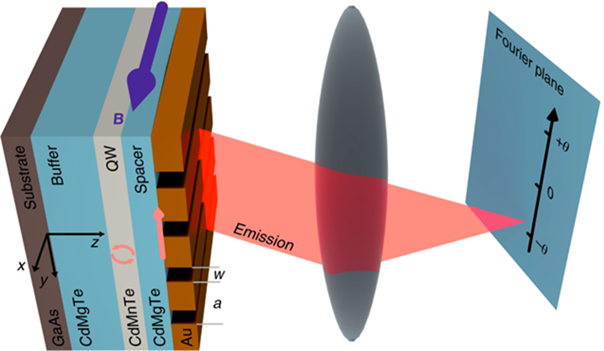News

Schematic presentation of the idea of experiment performed in order to demonstrate the strong TMRLE. Plasmonic structure (shown on the left) contained CdMnTe quantum well (QW) with CdMgTe barriers (blue). On the semiconductor structure’s surface Au grating with the period a = 250 nm and slit width w = 50 nm was produced. Thickness of Au layer was about 45 nm. The structure was placed in an external magnetic field B, located within the QW’s plane (blue arrow marked B). Angular dependence of emitted light was transformed with the use of a lens into the spatial dependence in the Fourier plane (right part of the figure) and detected as a contour pattern with a twodimensional charge-coupled device (CCD) matrix detector, attached to an imaging spectrometer (from F. Spitzer, et al., Nature Physics 14, 1043 (2018)).
The paper co-authored by Prof. Wojtowicz reports on a new class of optical phenomena where directionality of light emission is established perpendicular to the externally applied magnetic field for light sources located in the vicinity of a surface. As a proof of principle for this effect, called transverse magnetic routing of light emission (TMRLE), authors demonstrate the routing of emission for excitons in a diluted-magnetic-semiconductor (DMS) quantum well (QW) in hybrid plasmonic semiconductor structures. Taking advantage of both a strong enhancement of spin splitting characteristic of DMS and spin-locking of light in plasmonic structures (analogous to carrier spin-locking in topological insulators) directionality of up to 60% was achieved. Nat. Phys. 14, 1043 (2018), arXiv:1712.05703
See also news from Polish Press Agency and Institute of Physics Polish Academy of Sciences (both in Polish)
11-10-2018